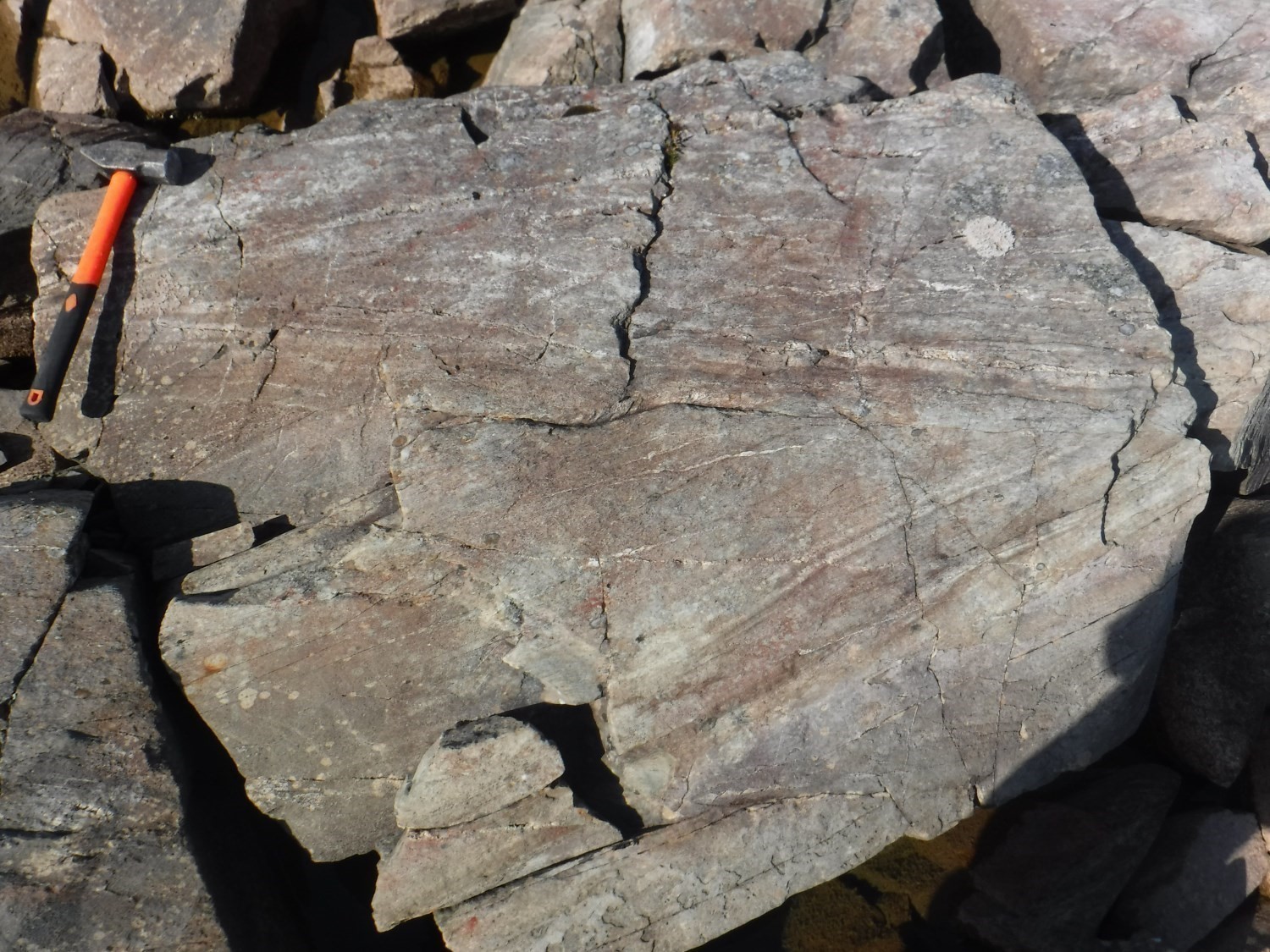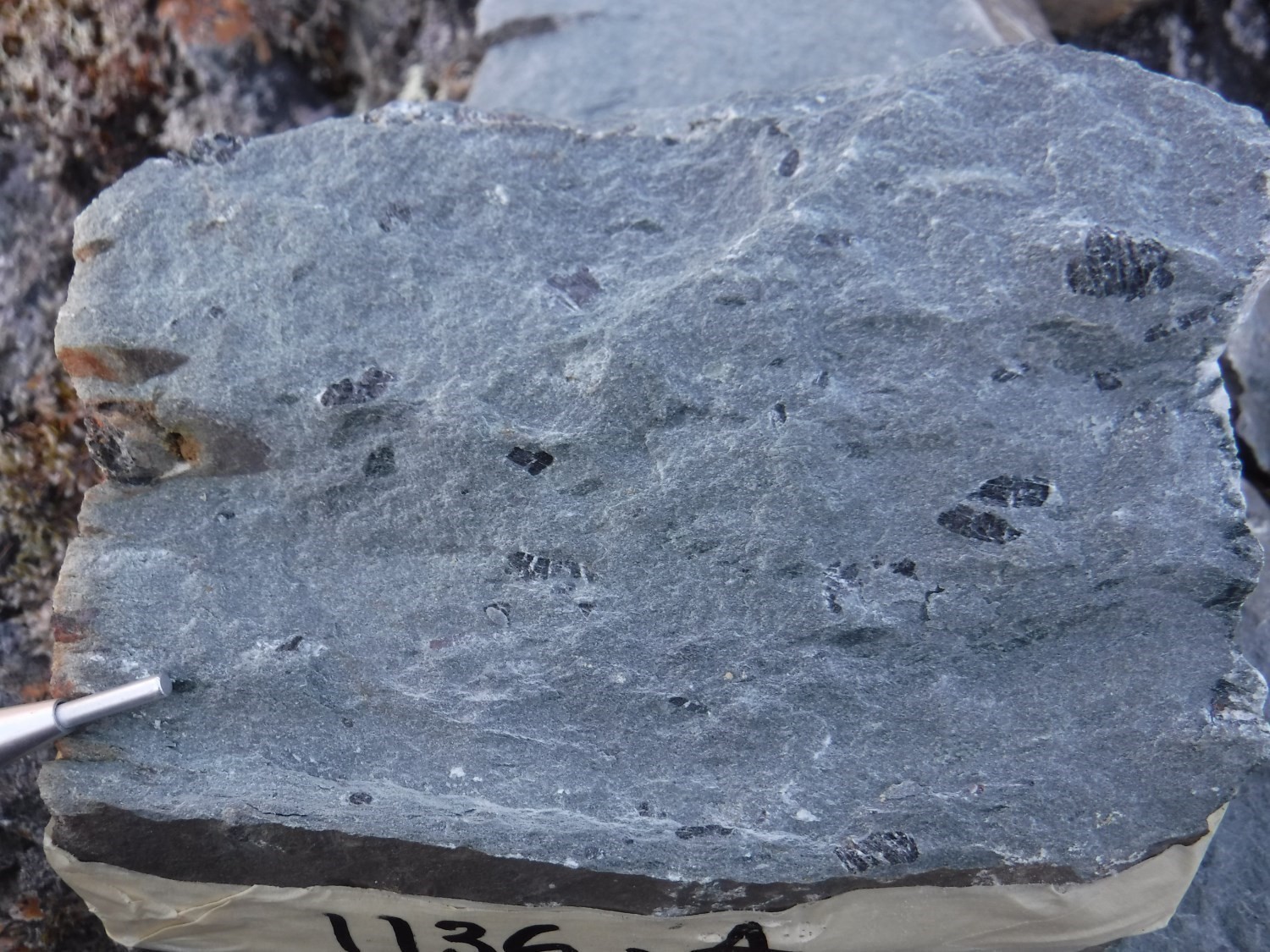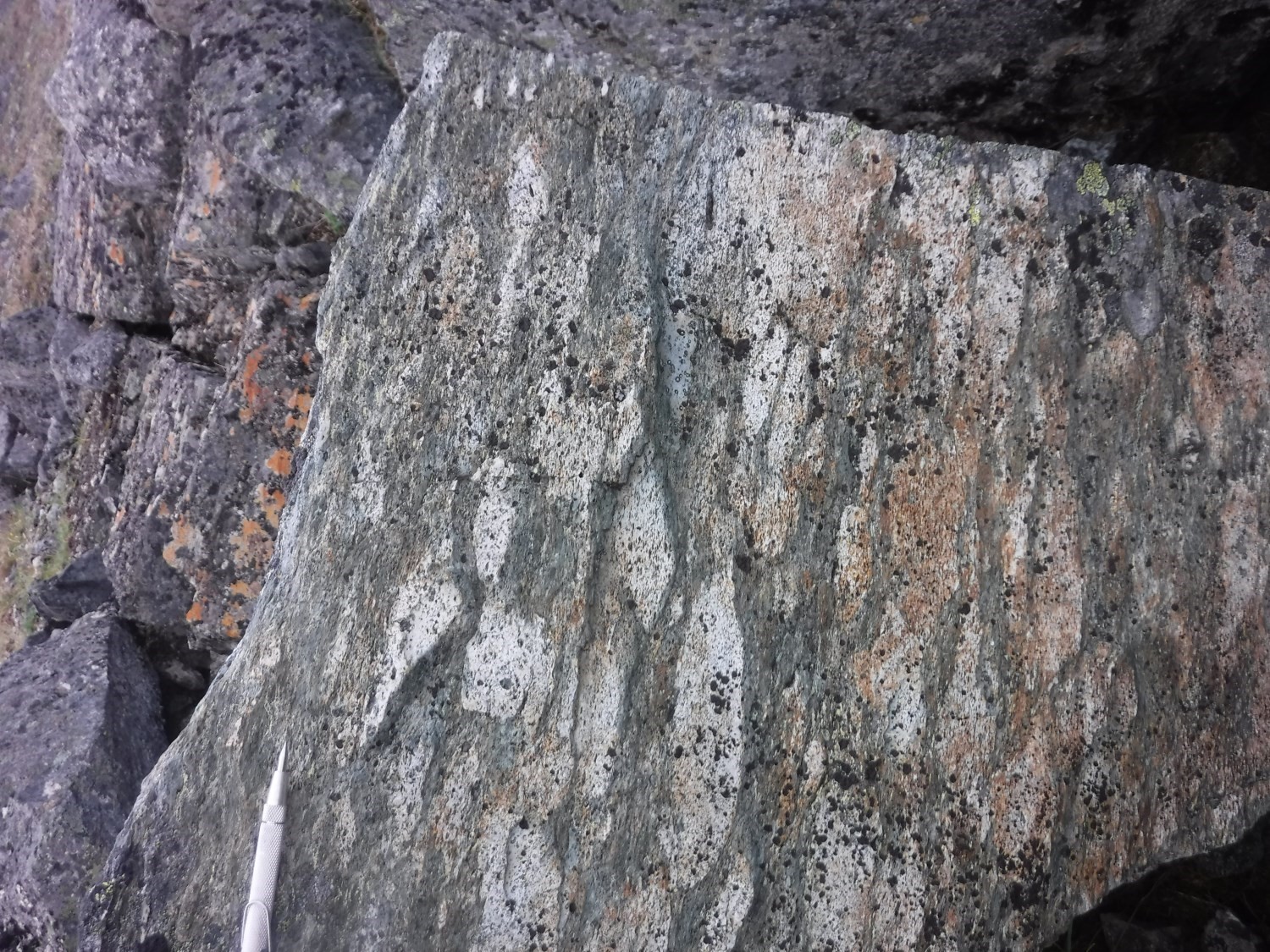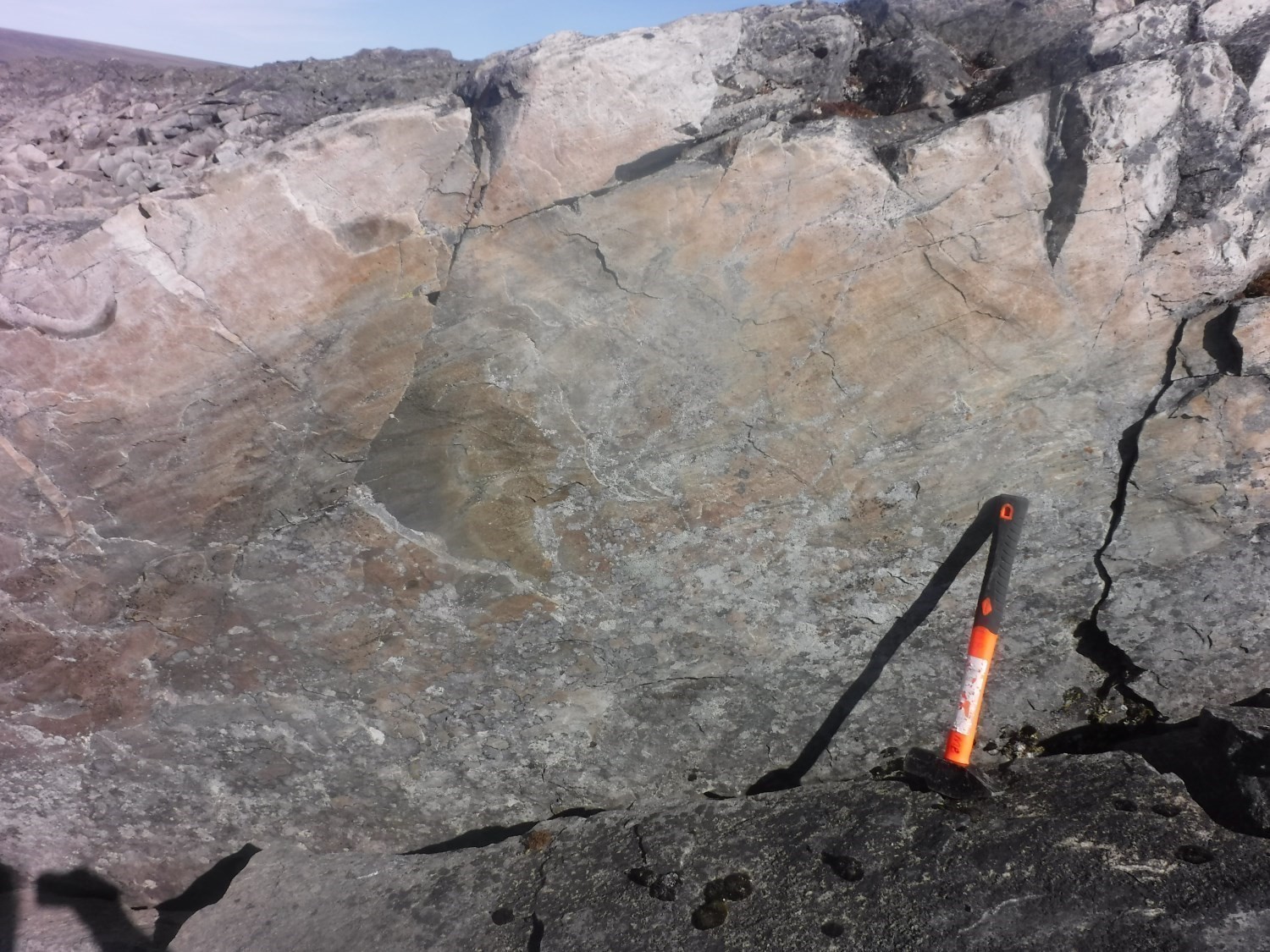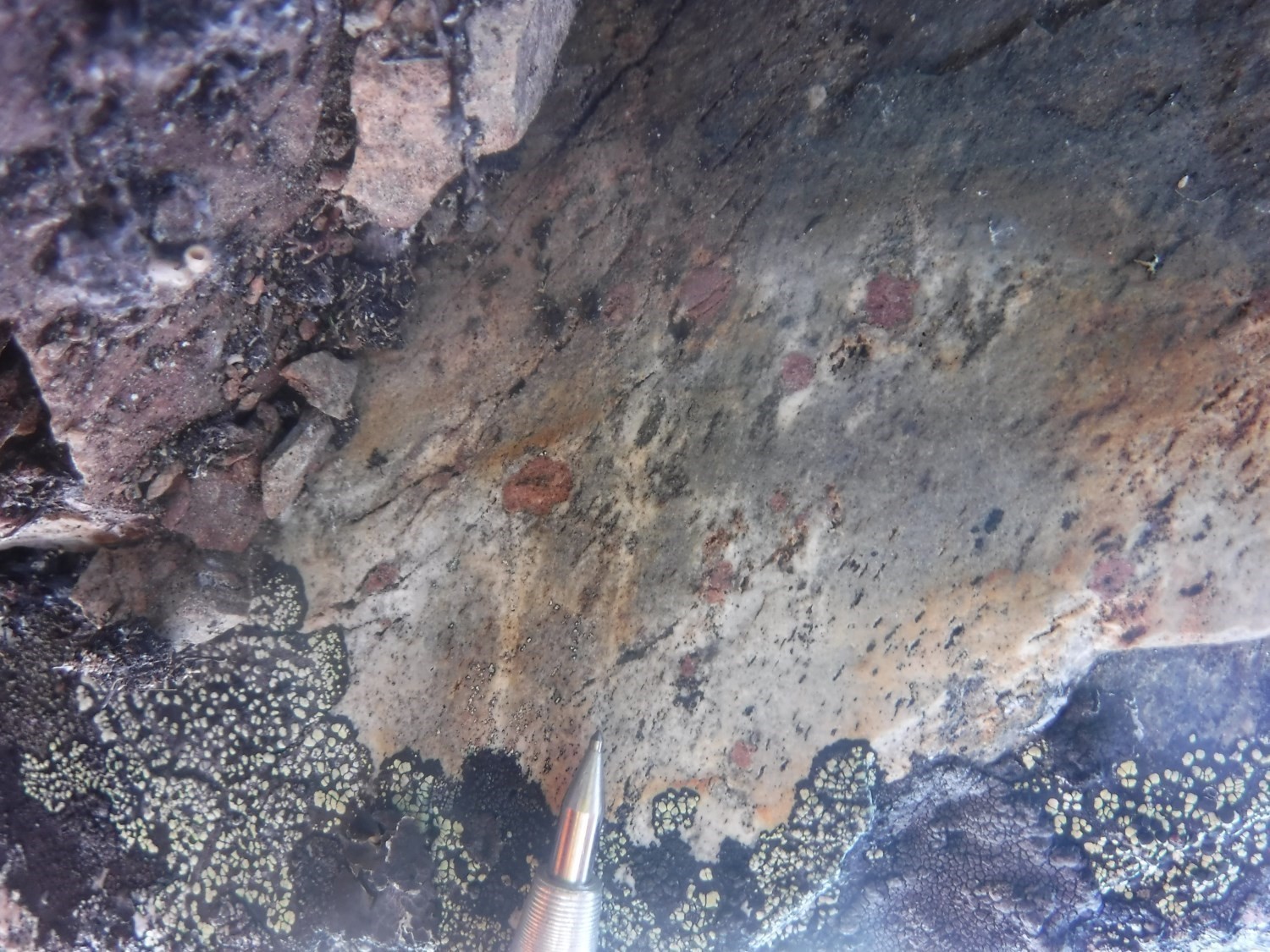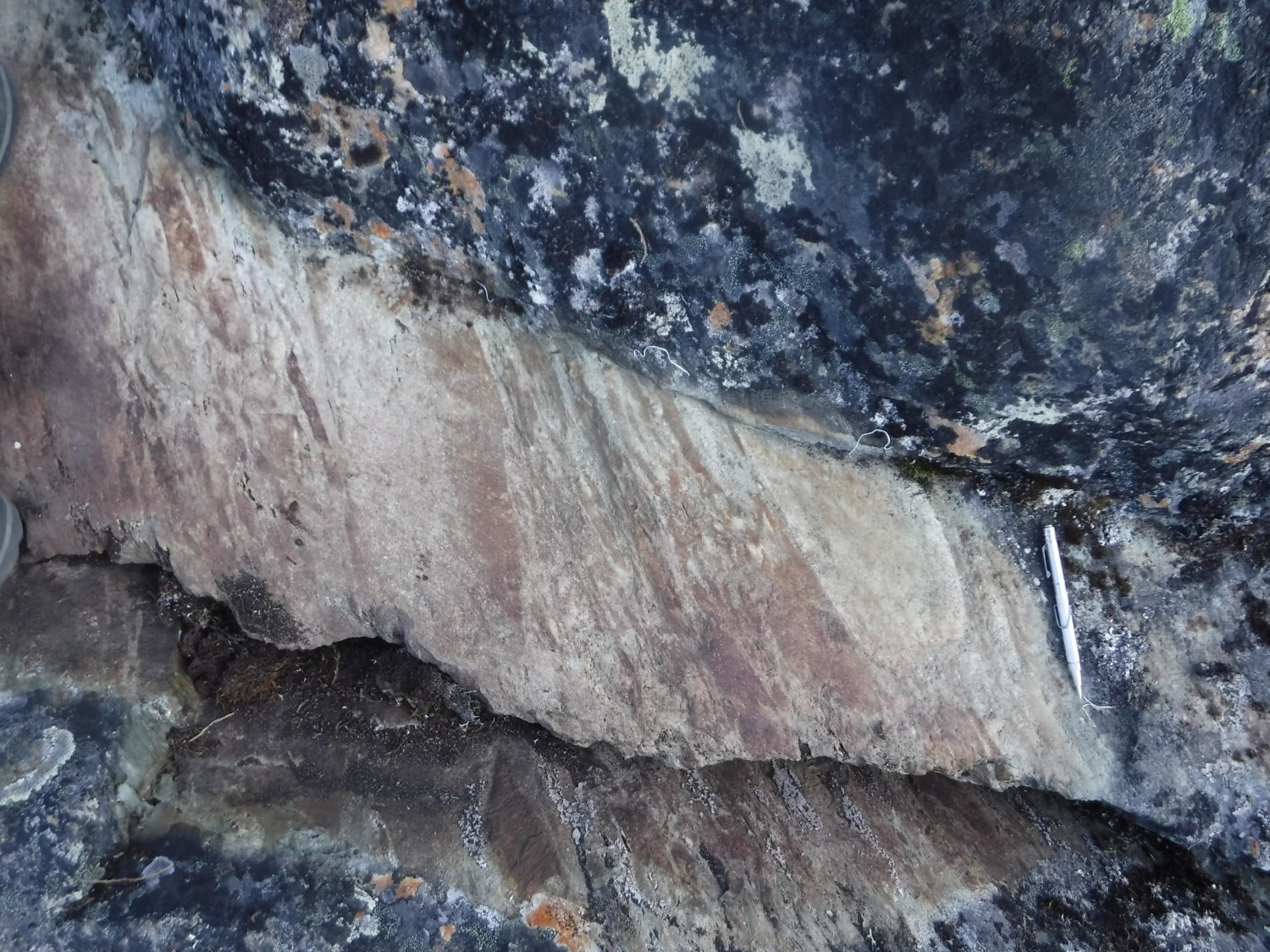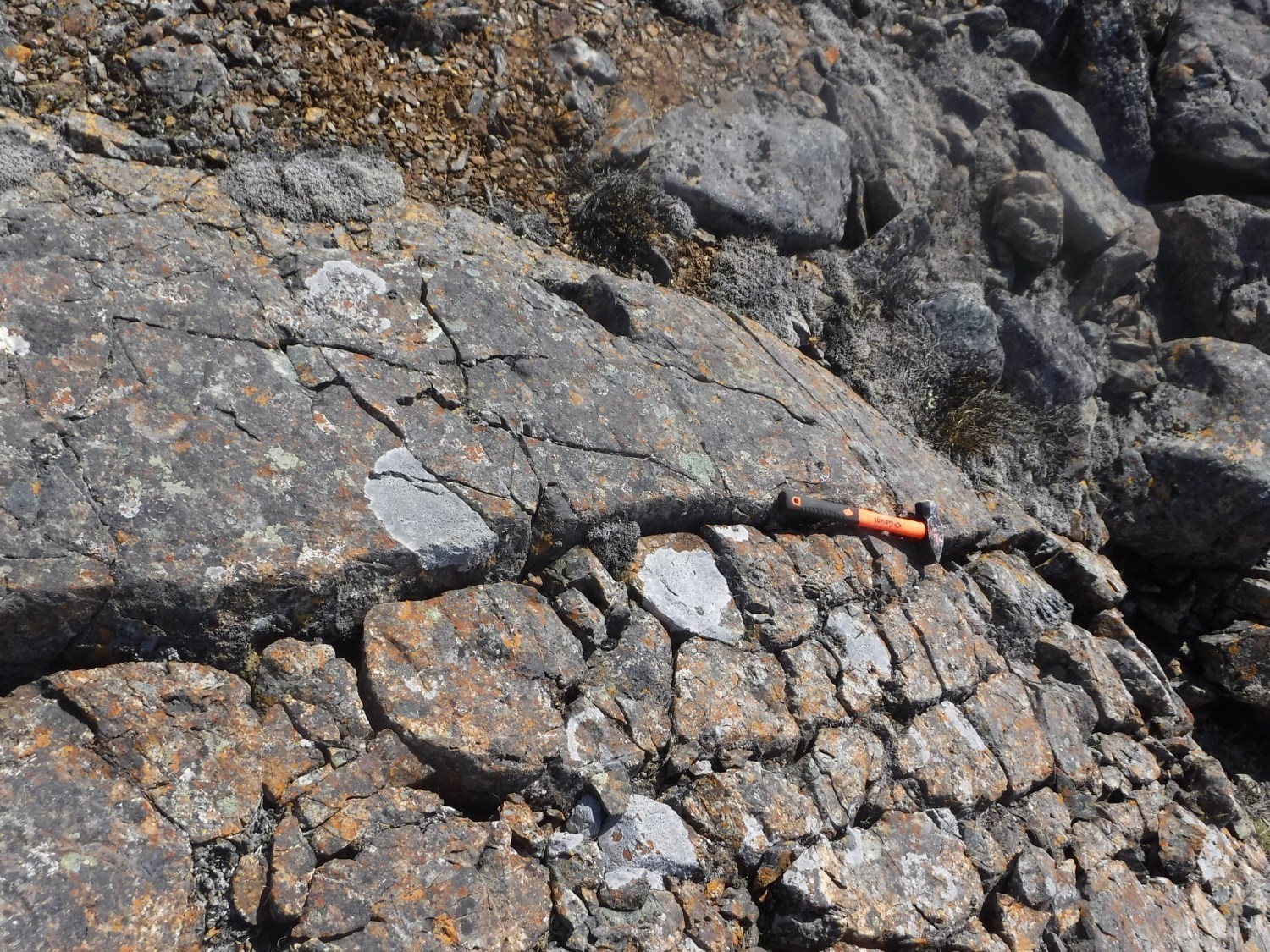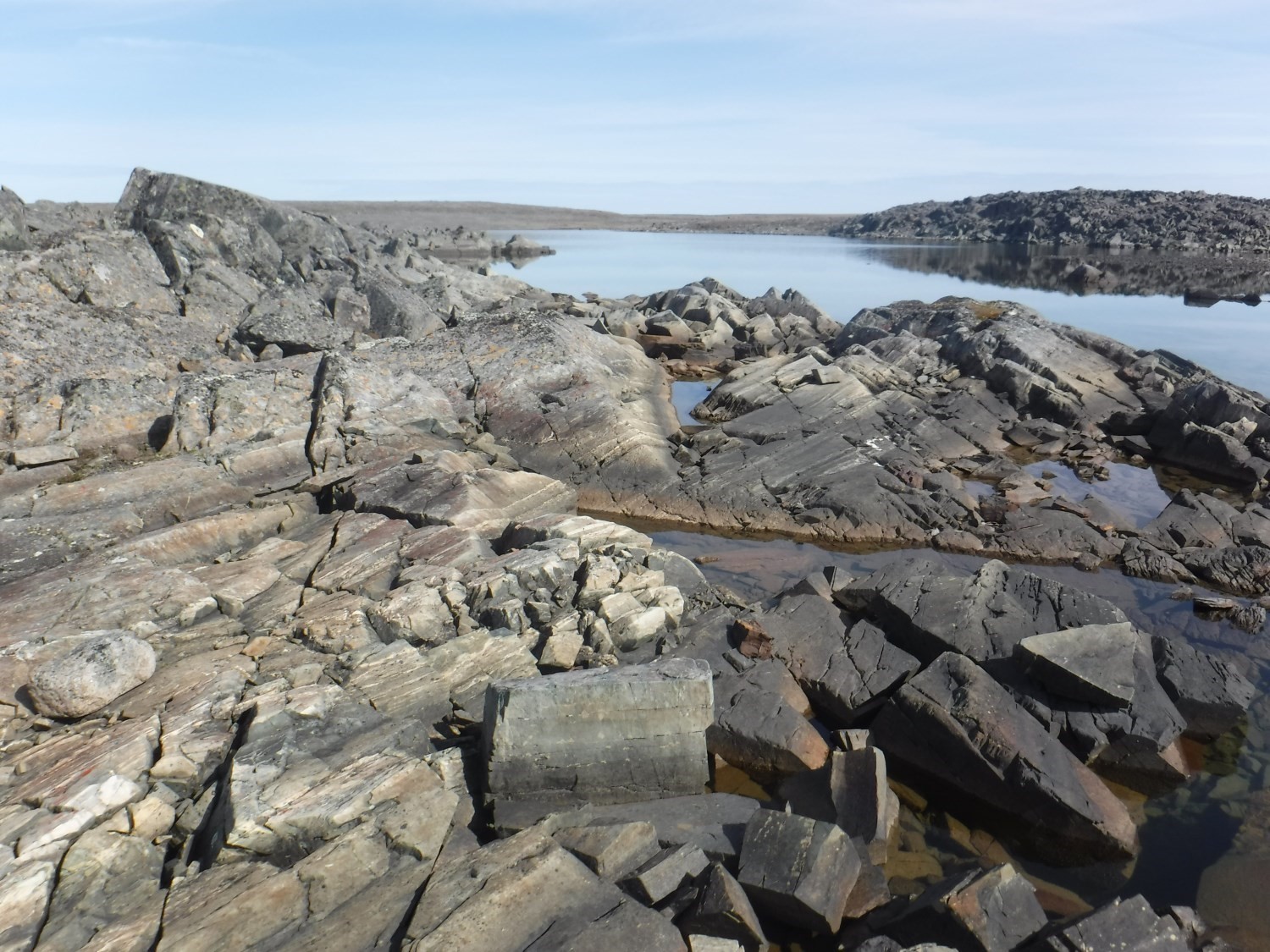
DISCLAIMER: This English version is translated from the original French. In case of any discrepancy, the French version shall prevail.
| Author: | Lamothe, 1994 |
| Age: | Paleoproterozoic |
| Stratotype: | None. The Parent Group is well exposed on outcrop 19-CB-1140, in the southern part of sheet 35G11. |
| Type area: | NTS sheets 35G12 and 35G11, as well as northern part of sheet 35G05 |
| Geological province: | Churchill Province |
| Geological subdivision: | Ungava Orogen / Northern Domain |
| Lithology: | Volcano-sedimentary rocks |
| Category: | Lithostratigraphic |
| Rank: | Group |
| Status: | Formal |
| Use: | Active |
None
Background
Rocks forming the Parent Group were originally attributed to the Watts Group (Lamothe et al., 1984; Hervet, 1985; Tremblay, 1989, 1991; Barrette, 1990a, 1990b). However, there are important lithological and geochemical differences between volcanic rocks of the Parent and Watts groups (Dunphy and Ludden, 1994; Scott et al., 1989). The Parent Group has an arc geochemical signature with strong Nb anomalies and a tholeiitic to calc-alkaline affinity (Dunphy and Ludden, 1994). The Watts Group, for its part, can be divided according to its geochemistry: the first package has a signature comparable to modern oceanic rift basalt defined by a flat spider diagram. The second displays a fractionated rare earth profile, but without significant Nb anomalies (Dunphy and Ludden, 1994). Finally, volcanic rocks of the Watts Group consist mainly of massive or pillow basaltic rocks, mafic sills and sheet dykes (Lamothe, 2007), whereas the Parent Group consists of a high proportion of volcaniclastics and mafic to intermediate lava.
Volcanic rocks and metasedimentary units were originally attributed to the Parent and Perrault groups, respectively (Lamothe, 1994). Following the synthesis of the Ungava Orogen (Lamothe, 2007), the use of the Perreault Group was abandoned and associated metasedimentary units were grouped in the Spartan Group. More recently, Mathieu et al. (2020) reassigned metasedimentary rocks in the northern part of sheet 35G11 to the Qaaneq Complex. They also introduced units pPpa9 to pPpa14.
Description
The Parent Group consists of a package of volcanic rocks formed mainly by massive, locally pillowed lava flows, which composition is mainly basaltic. This group also includes thick layers of lapilli tuff and, more locally, fine-grained tuff centimetre to decimetre-thick.
In sheet 35G11, some primary structures and textures are preserved, although there is a well-developed regional schistosity, generally accompanied by marked flattening of the original features of units. Some polarity indicators, such as pillows and sorting in tuff, could be identified. They all show normal polarity towards the north or NW. Fine-grained sedimentary beds, rich in sulphides and locally in iron oxides, are present in at least four different stratigraphic layers. These are marked by strong positive magnetic anomalies. The southern part of the Parent Group, north of the Bergeron Fault, includes two discontinuous beds of pyrrhotite mudrock corresponding to positive magnetic and electromagnetic anomalies. Finally, synvolcanic gabbro sills are present throughout the sequence.
In the same sheet, the Parent Group is divided into two main phases of basaltic to andesitic composition and aphyric or porphyritic texture. Each of these two lithologies has been subdivided into three using geochemistry (pPpa9a, b, c and pPpa10a, b, c). Dacitic extrusive volcanic rocks have also been identified in the northern part of the sheet. For these subunits, the geochemical affinity varies from tholeiitic to calc-alkaline, whereas in the western area (western part of the sheet), the affinity gradually becomes calc-alkaline (Picard et al., 1990), suggesting several magmatic sources for volcanism. In fact, in sheet 35G11, units pile up as more or less continuous lenses, the majority of which are present at several levels in the stratigraphy, supporting the hypothesis of the existence of different eruptive centres. Faults present throughout the sequence could also play a role in the repetition of units. However, the order in which the units are stacked is not repeated elsewhere in the sequence.
Parent Group 1 (pPpa1): Fine-Grained Lapilli Tuff
In the Lessard Lake area, tuffaceous facies schists have a grain size <0.5 mm and can contain up to 5% plagioclase or pyroxene phenocrystals. These schists are mainly composed of actinolite, plagioclase, quartz and chlorite. Brown biotite and carbonates can be observed. In addition, some layers can be highly epidotized (Tremblay, 1991).
Parent Group 2 (pPpa2): Block Tuff
In the Lessard Lake area, this unit consists of tuffaceous schist containing fragments of volcanic rocks containing pyroxene phenocrystals and a recrystallized granoblastic matrix (Tremblay, 1991).
Parent Group 3 (pPpa3): Aphanitic Basalt
This unit of the Parent Group consists of actinolite-chlorite schist having a dominant facies of massive and pillowed mafic volcanic rocks. Flows are metre to decametre thick. These rocks are brownish in altered surface and medium to dark green in fresh exposure. The rock is generally fine grained (<0.5 mm). It is partially recrystallized and the texture tends to be granoblastic. The mineralogy of these rocks is as follows: pyroxene, plagioclase, actinolite, chlorite, epidote and, locally, olivine, sphene, carbonates, biotite and opaque minerals (Tremblay, 1991).
In the Lessard Lake area, it is common to observe pillows, amygdules and other primary textures (Tremblay, 1991). In the Vanasse Lake area, primary textures are difficult to observe because these metavolcanics are generally effected by a more or less developed schistosity. The common presence of millimetric to centimetric amygdules is also noted (Tremblay, 1989).
Parent Group 4 (pPpa4): Plagioclase Basalt
The best preserved mafic volcanic rocks are found in the southern periphery of the Vanasse Lake area. Basalt is composed of millimetric phenocrystals of plagioclase (15-20%) and augite (10-15%), and the matrix (55%) locally occurs as altered glass. Amygdules are filled with epidote, chlorite and matrix (Tremblay, 1989).
Parent Group 5 (pPpa5): Pyroxene Basalt
In the Vanasse Lake area, the least well-preserved basalt contains highly altered plagioclase and pyroxene phenocrystals. Plagioclase is sericitized and chloritized, while pyroxenes are mostly chloritized. The matrix is composed of actinolite and chlorite with microlitic or partially recrystallized plagioclase crystals (Tremblay, 1989).
Parent Group 6 (pPpa6): Rhyolite
It should be noted that undifferentiated amphibolitic schist, with relics of pillowed and tuffaceous lava, forms layers (up to 5 km thick) south and SE of Chassé Lake. This apparent thickness is probably the result of tectonic repetition. Thinner lenses (200 m to 1 km) are isolated in a gabbro mass in the Lessard Lake area (Tremblay, 1991).
Parent Group 7 (pPpa7): Siltstone, Sandstone, Quartz-Feldspar-Biotite Schist
In the Vanasse Lake area, metasedimentary rocks interstratified with schists of volcanic origin form shallow beds (1-2 m) of quartz-feldspar-muscovite ± biotite schist corresponding to metawacke. Larger masses are present in the Belleau Lake area (Tremblay, 1989).
In the Lessard Lake area, metasedimentary rocks form a sequence ~2 km thick and ~20 km long. These rocks are represented by fine-grained quartz-muscovite ± biotite ± garnet schist having a granoblastic texture. They are generally very affected by schistosity. Coarser-grained beds corresponding to meta-arkose have also been observed locally (Tremblay, 1991).
Parent Group 8 (pPpa8): Plagioclase-Sericite-Ankerite Schist
This informal unit is only present east of Gagné Lake.
Parent Group 9 (pPpa9): Aphyric Volcanic and Volcaniclastic Basaltic Rocks
Aphyric lithologies of the Parent Group consist of basalt, locally pillow basalt, fine-grained tuff and monomictic lapilli tuff. Aphyric basaltic volcanic rocks have a greenish black patina, are homogeneous and fine grained to aphanitic. They contain 0-3% millimetric quartz amygdules. The pillow texture is not systematically described on aphyric basalt outcrops, it is observed on ~30% of outcrops. Where pillows are present, they are generally flattened. As the schistosity increases, it becomes more difficult to determine the polarity. However, polarities towards the NW have been identified using aphyric basalt pillows on the following outcrops: 19-MB-3109, 19-CB-1143 and 19-KL-9200. The best preserved pillows are located between the Bergeron and Qiqavik faults and on outcrop 19-KL-9200, ~10 km SE of Perrault lake. Pillows area 0.3 m to 1 m in size and show normal polarity towards the NNW. Locally, they are affected by radial cooling fractures present at the top of some pillows (outcrop 19-CB-1007).
Spherulites are also described in some outcrops, but are not characteristic of the unit. For example, on outcrop 19-MB-3121, a pillow breccia exhibits pillow fragments containing spherulite 1 mm to 8 mm. Their size and proportion increases towards the pillow’s core. From a microscopic perspective, the matrix of volcanic rocks is composed of an assemblage of epidote, chlorite, altered plagioclase, sphene, carbonates and opaque minerals. Augite crystals coarser grained than those of the matrix are locally observed and represent up to 20% of the composition.
This unit also includes finely bedded tuff layers. Beds are millimetric to decimetric and their colour in altered surface varies from dark grey to light greenish beige. Some beds exhibit sorting which dominant polarity is normal towards the NW (outcrops 19-CB-1140, 19-CB-1141, 19-MB-3120, 19-MB-3118). On outcrop 19-CB-1140, some sequences are truncated, defining a volcano-sedimentary pile which polarity is also towards the NW. On outcrop 19-MB-3118, fine-grained tuff exposes millimetric, fine dark laminae and lighter ones measuring up to 1 cm. Some laminae are rusty. On the main face of the outcrop, northward sorting is marked by beds varying progressively from coarse to fine tuff. The sharp contact between the top of the bed (fine tuff) and the beginning of the next (coarse tuff) is observed 10 times. Beds vary from 15 cm to 1.5 m. The 1.5 m bed represents TA-TB-TD horizons of the Bouma sequence, whereas most beds contain only TA-TD horizons. Schistosity is very poorly developed over the entire outcrop. However, micas observed with a magnifying glass are oriented in the bedding plane, suggesting that schistosity is parallel to bedding.
Monomictic lapilli tuff containing aphyric fragments is less important in terms of proportion and represents <5% of the unit. Where lapillis are present, they are aphyric and dark grey. On outcrops 19-MB-3006 and 19-MB-3117, fragments are strongly flattened (10 to 1). The matrix is beige and fine to coarse grained. Schistosity is well developed. On outcrop 19-CB-1141, lapillis are ovoid and represent ~20% of the rock. They are light grey and 2 mm to 5 mm in size. The matrix is light green and locally contains loose plagioclase crystals. These are stocky, whitish and millimetre-sized. Their content varies from 0 to 15% and they are concentrated only in certain layers.
The following subunits have been defined according to their geochemical signature (Mathieu et al., 2020).
Parent Group 9a (pPpa9a): Tholeiitic Basalt
Samples from subunit pPpa9a plot in the basalt field of Winchester and Floyd (1977) diagrams. Their magmatic affinity is clearly tholeiitic, as shown in the Ross and Bédard (2009) affinity diagram. Their spider diagram is generally smooth and has a slightly positive slope.
Parent Group 9b (pPpa9b): Tholeiitic to Transitional Basalt
Tholeiitic to transitional basalt is characterized by a slightly sloping spider diagram. This group can be divided into two subgroups according to geochemistry. The first has a strong negative Nb anomaly and a weaker negative Ti anomaly. According to the diagram of Agrawal et al. (2008), its formation environment is an island arc. The second group does not show any characteristic anomaly and its geochemical signature is typical of an oceanic rift (Ross and Bédard, 2009). Since the two groups are similar and geographically associated, they have been merged to facilitate geological interpretation.
Parent Group 9c (pPpa9c): Transitional to Calc-Alkaline Basalt
Transitional to calc-alkaline basalt has a steeply sloping spider diagram. Nb and Ti anomalies vary from slightly to highly negative.
Parent Group 10 (pPpa10): Pyroxene Porphyroclastic Volcanic and Volcaniclastic Rocks
This porphyritic rock unit is characterized by the presence of 7-15 mm thick clinopyroxene phenocrystals, which content varies from 5 to 15%. Millimetre-long plagioclase phenocrystals are locally present (up to 10% of the rock). Plagioclase crystals are typically smaller (~1 mm) than clinopyroxene crystals. On outcrops, phenocrystals are visible in altered surface and in fresh exposure.
The porphyritic unit includes coherent greenish volcanic rocks (19-CB-1136), flow breccia (19-MB-3105) and monomictic porphyritic lapilli tuff (19-MB-3043). Lava has a dark grey patina and does not appear to be particularly affected by deformation on outcrops. The rock is homogeneous, as is the distribution of clinopyroxene phenocrystals. The apparent thickness of lava layers is at least 2 m (19-GL-2054), but can reach 25 m (19-GM-5057). On outcrop 19-MB-3105, a flow breach was observed in porphyritic lava layers. Indeed, a variation in the fragmentation proportion is marked by the presence of aphanitic material (interpreted as hyaloclastic rocks) defining distinct fragments. For example, a 1.3 m block with pillow margins has been described: it contains ~30% amygdules, 15% pyroxene (1-4 mm) and 5-10% plagioclase (1 mm). On contact with this block, the breccia is monomictic and fragments are of the same composition as the adjacent lava, but their amygdule content is variable (0-30%). Fragments are ovoid and 1 cm to 30 cm in size.
This unit also consists of monomictic porphyritic lapilli tuff. They are beige in altered patina and contain 5-50% porphyritic lapillis. The latter are ovoid or flattened depending on the intensity of the deformation. Lapilli tuff layers are metre thick, so that contact with other units or primary bedding is not always visible on outcrops. On outcrop 19-GM-5065, the apparent thickness of volcaniclastic rocks is 10 m and volcaniclastics are in contact with pyroxene porphyritic basalt. On outcrop 19-BC-7025, although lapilli tuff is ~50 m thick (discontinuous outcrop), no evidence of bedding was observed. This could be explained by the poor quality of outcrops, by excessive deformation, or by the intrinsic characteristics of volcaniclastics. However, bedding is locally marked by variation in the size and proportion of lapillis. For example, on outcrop 19-CB-1066, some layers are less rich in pyroxene phenocrystals. On the other hand, the quality of outcrops (abundant lichen) does not allow a good view of the contact, so no bedding measurements were taken in lapilli tuff. In addition to fragments of porphyritic volcanic rocks, the matrix may also contain loose clinopyroxene and plagioclase phenocrystals. Clinopyroxene phenocrystals are stocky (2-7 mm) and can account for up to 20% of the lithology. Plagioclase is also stocky (1-3 mm). Typically, schistosity is better developed in tuff layers than in lava layers. Indeed, the matrix is generally highly schistose and lapillis are flattened in the schistosity plane.
In thin section, porphyritic basalts are composed of augite phenocrystals and a variable amount of millimetric plagioclase laths in a microblastic and amygdaloidal matrix of epidote (zoisite ± pistachite), leucoxene, chlorite ± actinolite. Augite phenocrystals are generally subhedral, twinned, zoned and partially altered to actinolite and chlorite. Plagioclase crystals consist of albite-oligoclase more or less impregnated with neoformed zoisite, sericite and locally chlorite. Finally, amygdules (up to 20%) are filled with an assemblage of epidote, calcite and chlorite. Some more andesitic flows have a glomerophyric texture characterized by elongated plagioclase lath clusters in a vacuolar and microlitic plagioclase matrix containing a small amount of pyroxene crystals (Picard, 1995).
Parent Group 10a (pPpa10a): Tholeiitic Basalt
This member has a tholeiitic geochemical affinity and presents an oceanic rift signature according to the diagram of Agrawal et al. (2008). Its spider diagram displays negative anomalies in Th and Zr.
Parent Group 10b (pPpa10b): Tholeiitic to Transitional Basalt
Basalt having a low Zr content is of tholeiitic to transitional affinity and has a signature between island arc and oceanic rift basalt, according to the diagram of Agrawal et al. (2008). Its spider diagram is characterized by strong negative anomalies in Nb, Ta, Zr, Hf and Ti.
Parent Group 10c (pPpa10c): Transitional to Calc-Alkaline Basalt
Basalt and andesite having a high Zr content are of transitional to calc-alkaline affinity and have a signature between island arc and oceanic rift basalts, according to the diagram of Agrawal et al. (2008). They are distinguished from pPa10b basalt by their spider diagram without Zr or Hf anomalies. However, their profile has negative anomalies in Nb, Ta and Ti.
Parent Group 11 (pPpa11): Aphyric Dacite
Dacite occurs in the northern part of the Parent Group. It is particularly well exposed on outcrop 19-MB-3071. On outcrops, it can be distinguished from other volcanic units by its very light whitish-grey patina and its very fine to aphanitic grain size. It contains 0-25 % rounded poikilitic garnet (5-10 mm), concentrated in the vicinity of coarser-grained zones. These zones are mainly composed of white plagioclase (~5 mm) and 10% hornblende (<1 mm) which mark foliation. Zones are centimetre to decimetre-thick and randomly distributed. They can be rounded or elongated. Locally, they appear to occur as injections. In the northern part of sheet 35G11, metamorphism ranges from the upper greenschist facies to the amphibolite facies, which explains the presence of garnet and hornblende in dacite. No primary textures were observed in the rock. Geochemically, dacite has a transitional to calc-alkaline affinity, an island arc signature and strong negative Nb and Ti anomalies.
Parent Group 12 (pPpa12): Polymictic Lapilli and block Tuff
Polymictic volcaniclastic rocks consist of lapilli or block tuffs containing fragments of various kinds. The majority of fragments come from aphyric or pyroxene ± plagioclase porphyritic mafic volcanic rocks. The source of these fragments could correspond to units pPpa9 and pPpa10. Aphanitic felsic or dark grey chert fragments have been described locally (19-MB-3119, 19-MB-3006, 19-SL-4195), but are not characteristic of the unit. Lapillis generally have an ellipsoidal shape due to deformation. On outcrop 19-MB-3042, polymictic lapilli and block tuff is well exposed and is a typical example of this unit. Its thickness at this location is ≥50 m. Fragments are flattened (5 to 1) and represent 90% of the composition. Lapilli and block tuff contains mainly fragments of clinopyroxene porphyritic volcanic rocks, plagioclase porphyritic volcanic rocks, and aphyric and amygdaloidal volcanic rocks. Locally, a pink granite fragment is observed. Fragments are flattened and phenocrystals are stocky.
On outcrop 19-MB-3118, lapilli tuff is well exposed and very little deformed. It contains two main types of lapillis that account for 30-40% of the rock. The first type of lapilli is light beige and aphanitic, and the second is aphanitic greenish grey. The majority (90%) of lapillis are millimetric (2-10 mm), while 10% of the lapilli are coarser and centimetric. Plagioclase rods vary from 1 mm to 5 mm and represent ~30% of tuff. The grain size of lapillis gradually decreases northward until it reaches <2 mm (coarse-grained ash tuff). Lapillis are angular to subangular and only slightly deformed. Further north, a series of turbidite deposits of fine to coarse tuff (pPpa9) can be found. From a geochemical perspective, geochemical analyses of polymictic volcaniclastic rocks are dependent on fragments analyzed. Thus, the distribution of analyses in different diagrams does not form any significant grouping.
Parent Group 13 (pPpa13): Synvolcanic Gabbro Sill
Gabbro sills were emplaced in the volcanic sequence. They are coarser grained, more competent and seem less altered than the volcanic host. Their thickness is not always significant, and therefore cannot be mapped. Their actual proportion is not represented on the map. In the southern part of the Parent Group, gabbroic sills occur between the Bergeron and Mivvik faults. Gabbro is mesocratic, fine grained, homogeneous and massive. It contains traces of pyrrhotite (19-SM-6010). On outcrop 19-GL-2150, gabbro is medium grained and 50 m thick. On outcrop 19-MB-3113, the gabbro sill contains coarse stocky pyroxenes. It is in contact to the north and south with pillow basalts, which indicates that the sill is indeed parallel to stratigraphy.
Further north, west of dacite (pPpa11), sills have been interpreted using geophysics. Indeed, positive magnetic anomalies are present on the magnetic geophysical survey while surface lithologies are not magnetic. As anomalies are parallel to volcanic unit contacts and are geographically within the volcanic sequence, these polygons were assigned to the Parent Group. Indeed, these anomalies have been interpreted as magnetic sills. However, the source of these anomalies could be quite different, such as deep intrusions, for example.
Parent Group 14 (pPpa14): Pyrrhotitic Mudstone, Iron Formation and Chert
This unit consists of four marker layers oriented E-W in sheet 35G11. Although the unit outcrops poorly, it is particularly visible on geophysical maps due to its characteristic signature defined by strong magnetic and conductive linear anomalies.
The first two layers are located between the Bergeron and Mivvik faults and affected by folding. They consist of pyrrhotite mudstone and a minor amount of chert. Pyrrhotitic mudstone is exposed on outcrop 19-SM-6143, where its thickness varies from 5 m to 50 m. On outcrops 19-MB-3133 and 19-MB-3108, pyrrhotite mudstone has a thickness of 1 m. It is schistose, rust-coloured and in contact with basalt on both sides. Sulphides, mainly pyrrhotite, account for ~40% of the rock. On outcrop 19-MB-3108, beds are millimetric; some of them are more cherty, while others contain sulphides. A thin (<10 cm) layer of chert containing millimetric laminae was also described on outcrop 19-GM-5179.
The third marker layer is located south of the Sanimuapik Suite (pPsak), near the Qiqavik Fault. Pyrrhotitic chert has been described on outcrop 19-GM-5062. The pyrrhotite chert layer is rust-coloured and varies in thickness from 50 cm to 1 m. It is very fine grained and displays laminations. In the vicinity of the Qiqavik Fault, a metric dyke of altered ultramafic rocks has a strong magnetic signature (19-MB-3091), which may influence the geophysical signal associated with pyrrhotite. Thus, the continuity of pyrrhotite chert described on outcrop 19-GM-5062 is not well constrained.
Finally, the last layer is located in the northern part of the Parent Group, SW of dacite (pPpa11). This unit consists of oxide facies iron formation and is particularly well exposed on outcrop 19-SL-4106. Fine magnetite beds are interstratified with quartzose layers and garnet mudstone beds. Bedding is centimetric to decimetric, the thickness of the iron formation varies from 1 cm to 50 cm. Some beds within the sequence contain up to 1% fine disseminated pyrite, giving them a rusty colour.
Thickness and Distribution
The Parent Group occurs north of the Bergeron Fault, in the Northern Domain of the Ungava Orogen. It is in contact to the north and east with units of the Cape Smith Suite and Watts Group. According to the work of Lamothe (2007), the Parent Group extends westward to the contact between the Southern Domain and the Kovik Lithotectonic Domain in the Bilson Lake area (sheet 35F11). Its apparent thickness (N-S) varies from 2 km to 20 km. More precisely, it occurs in the half-south of sheets 35G11 and 35G12 and, to a lesser extent, in the southern part of sheets 35G10 and 35F09. It also occurs in the northern part of sheet 35G05.
Dating
A maximum U-Pb age of 1917 Ma for a magmatic zircon was obtained in an epiclastic felsic unit also containing Archean zircons with ages >2.4 Ga. This unit, located south of Perrault Lake, was first described as rhyodacite. However, the presence of inherited zircons and rounded feldspar grains suggests a sedimentary rock or volcaniclastic rock containing a detrital contribution. Thus, this age is interpreted as the maximum age of deposition of the unit (Machado et al., 1993). A U-Pb age of ~1860 Ma was obtained on rhyolite at the western contact between the Northern and Southern domains and the Narsajuaq Lithotectonic Domain (Machado et al., 1993). It is mentioned that this sample contains a high content in common lead.
Stratigraphic Relationship(s)
Stratigraphic relationships between the Parent group and adjacent units are marked by numerous thrust faults that cut the Northern Domain. No direct transition or primary contact was observed with the Watts, Spartan and Chukotat groups. Thus, stratigraphic relationships with other components of the Northern Domain cannot be established at this stage. St-Onge et al. (2001, 2002) consider that units of the Northern Domain show no tectonostratigraphic or intrusive relationships with those of the Southern Domain.
In sheet 35G11, the Parent Group is cut by several generations of intrusions, namely the Qikirtalialuk, Sanimuapik and Iqiat suites. The southern boundary of the Parent Group is also in fault contact (Bergeron Fault) with the Chukotat Group to the south. The Foucault Suite presents similarities with the porphyritic unit of the Parent Group (pPpa10), notably by the presence of hornblende phenocrystals. However, in the Foucault Suite, phenocrystals consist of hornblende, whereas in the Parent Group, phenocrystals consist of clinopyroxene. The increase in the degree of metamorphism towards the north may explain the replacement of clinopyroxene phenocrystals by hornblende. Thus, the Foucault Suite (pPfoc2) could be the metamorphic equivalent of the Parent Group’s volcanic sequence.
Paleontology
Does not apply.
References
Publications Available Through SIGÉOM Examine
LAMOTHE, D., 2007. LEXIQUE STRATIGRAPHIQUE DE L’OROGENE DE L’UNGAVA. MRNF. DV 2007-03, 66 pages and 1 plan.
MATHIEU, G., BEAUDETTE, M., BILODEAU, C. 2020. Géologie de la région du lac Parent, Fosse de l’Ungava, Nunavik, Québec, Canada. MERN. BG 2020-04, 1 plan.
PICARD, C., 1995. SYNTHESE PETROGEOCHIMIQUE DES ROCHES VOLCANIQUES PROTEROZOIQUES DE LA CEINTURE OROGENIQUE DE L’UNGAVA : EVOLUTION GEOLOGIQUE DES GROUPES DE POVUNGNITUK, DE CHUKOTAT ET DE PARENT. MRN. MB 95-01, 257 pages.
TREMBLAY, G., 1989. GEOLOGIE DE LA REGION DU LAC VANASSE (FOSSE DE L’UNGAVA). MRN. ET 87-08, 29 pages and 2 plans.
TREMBLAY, G., 1991. GEOLOGIE DE LA REGION DU LAC LESSARD (FOSSE DE L’UNGAVA). MRN. ET 88-09, 32 pages and 2 plans.
Other Publications
MACHADO, N., DAVID., SCOTT, D.J., LAMOTHE, D., PHILIPPE, S., GARIÉPY, C., 1993. U-Pb geochronology of the Western Cape Smith Belt, Canada: new insights on the age of initial rifting and arc magmatism. Precambrian research, volume 63, pages 211-223. doi.org/10.1016/0301-9268(93)90034-Y
AGRAWAL, S., 2008. Tectonic discrimination of basic and ultrabasic volcanic rocks through log-transformed ratios of immobile trace elements. International Geology Review; volume 50, pages 1057-1079. doi.org/10.2747/0020-6814.50.12.1057
DUNPHY, J.M., LUDDEN, J.N., 1998. Petrological and geochemical characteristics of a paleoproterozoic magmatic arc (Narsajuaq terrane, Ungava orogen, Canada) and comparisons to Superior province granitoids. Precambrian research, volume 91, pages 109-142. doi.org/10.1016/S0301-9268(98)00041-2
ROSS, P.-S., BÉDARD, J.H., 2009. Magmatic affinity of modern and ancient subalkaline volcanic rocks determined from trace-element discriminant diagrams. Canadian Journal of Earth Science; volume 46, pages 823-839. doi.org/10.1139/E09-054
ST-ONGE, M.R., LUCAS, S.B., 1993. Geology of the Eastern Cape Smith belt: parts of the Kangiqsujuaq, cratère du Nouveau-Québec, and lacs Nuvilik map areas, Québec. Geological survey of Canada, Memoir 438. doi.org/10.4095/183988
WINCHESTER, J.A., FLOYD, P.A., 1977. Geochemical discrimination of different magma series and their differentiation products using immobile elements. Chemical Geology; volume 20, pages 325-343. doi.org/10.1016/0009-2541(77)90057-2
Suggested Citation
Ministère de l’Énergie et des Ressources naturelles (MERN). Parent Group. Quebec Stratigraphic Lexicon. http://https://gq.mines.gouv.qc.ca/lexique-stratigraphique/province-de-churchill/groupe-de-parent_en [accessed on Day Month Year].
Contributors
|
First publication |
Mélanie Beaudette, GIT, B.Sc. melanie.beaudette@mern.gouv.qc.ca; Carl Bilodeau, P. Geo., M.Sc. carl.bilodeau@mern.gouv.qc.ca (redaction) Mehdi A. Guemache, P. Geo., Ph.D. (coordination); James Moorhead, P. Geo., M.Sc. (critical review); Simon Auclair, P. Geo., M.Sc. (editing); Céline Dupuis, P. Geo., Ph.D. (English version); Ricardo Escobar Moran (HTML editing). |


